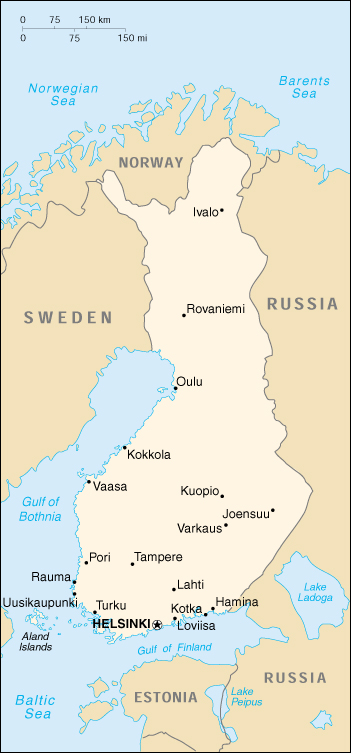
Suomen Tasavalta
(Republic of Finland)
Ruled by Sweden from the 12th to the 19th centuries and by Russia from 1809, Finland finally won its independence in 1917. The Finns have made a remarkable transformation from a farm/forest economy to a diversified modern industrial economy. As a member of the European Union, Finland was the only Nordic state to join the euro system at its initiation in January 1999.
Chief of state is President Tarja Halonen (since 1 March 2000; next presidential election to be held in February 2006). Prime Minister Matti Vanhanen (since 24 June 2003) and Deputy Prime Minister Antti Kalliomaki (since 17 April 2003).
Captial of Finland is Helsinki (northernmost national capital on European continent), and Independence Day, 6 December is the National Holiday.

|
Location: Northern Europe, bordering the Baltic Sea, Gulf of Bothnia, and Gulf of Finland, between Sweden and Russia.
The area is approximately 337,030 sq km (305,470 sq km land. 31,560 sq km water). Terrain is mostly low, flat to rolling plains interspersed with lakes and low hills. Climate consists of cold temperate; potentially subarctic, but comparatively mild because of moderating influence of the North Atlantic Current, Baltic Sea, and more than 60,000 lakes.
Population: About 5,190,785 people live in Finland.
The majority of residents are Finn(s) (93%). Other ethnic groups include Swede (6)%, Sami (0.11%), Roma (0.12%), and Tatar (0.02%). The population is concentrated on the small southwestern coastal plain. Main languages spoken are Finnish 93.4% (official), and Swedish 5.9% (official), as well as small Sami- and Russian-speaking minorities.
Religious Denomination: Evangelical Lutheran (89%), Greek Orthodox (1%), other (1%), and none (9%).
Agriculture: Products include cereals, sugar beets, potatoes; dairy cattle, and fish.
Economy: Finland has a highly industrialized, largely free-market economy, with per capita output roughly that of the UK, France, Germany, and Italy. Its key economic sector is manufacturing - principally the wood, metals, engineering, telecommunications, and electronics industries. Trade is important, with exports equaling more than one-third of GDP. Except for timber and several minerals, Finland depends on imports of raw materials, energy, and some components for manufactured goods. Because of the climate, agricultural development is limited to maintaining self-sufficiency in basic products. Forestry, an important export earner, provides a secondary occupation for the rural population.
Currency: Markka (FIM); Euro (EUR).

